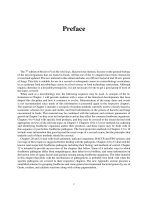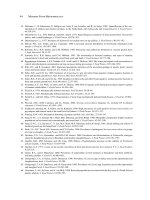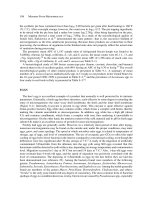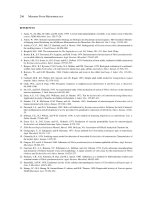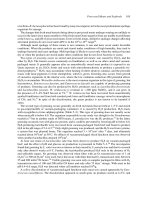Modern food microbiology 7th ed phần 14
Bạn đang xem bản rút gọn của tài liệu. Xem và tải ngay bản đầy đủ của tài liệu tại đây (73.44 KB, 5 trang )
Intrinsic and Extrinsic Parameters of Foods That Affect Microbial Growth
51
bacteria such as some members of the genus Bacillus. Some aerobic bacteria actually grow better
under slightly reduced conditions, and these organisms are referred to as microaerophiles. Examples
of microaerophilic bacteria are lactobacilli and campylobacters. Some bacteria have the capacity to
grow under either aerobic or anaerobic conditions. Such types are referred to as facultative anaerobes.
Most molds and yeasts encountered in and on foods are aerobic, although a few tend to be facultative
anaerobes.
With regard to the Eh of foods, plant foods, especially plant juices, tend to have Eh values of from
+300 to 400 mV. It is not surprising to find that aerobic bacteria and molds are the common cause of
spoilage of products of this type. Solid meats have Eh values of around −200 mV; in minced meats,
the Eh is generally around 200 mV. Cheeses of various types have been reported to have Eh values on
the negative side, from −20 to around −200 mV.
With respect to the Eh of pre-rigor as opposed to post-rigor muscles, Barnes and Ingram2,3 undertook
a study of the measurement of Eh in muscle over periods of up to 30 hours postmortem and its effect
on the growth of anaerobic bacteria. These authors found that the Eh of the sternocephalicus muscle
of the horse immediately after death was +250 mV, at which time clostridia failed to multiply.
At 30 hours postmortem, the Eh had fallen to about 30 mV in the absence of bacterial growth.
When bacterial growth was allowed to occur, the Eh fell to about 250 mV. Growth of clostridia was
observed at Eh values of 36 mV and below. These authors confirmed for horse meat the finding
for whale meat: that anaerobic bacteria do not multiply until the onset of rigor mortis because of
the high Eh in pre-rigor meat. The same is undoubtedly true for beef, pork, and other meats of this
type.
Eh Effects
Microorganisms affect the Eh of their environments during growth just as they do pH. This is true
especially of aerobes, which can lower the Eh of their environment while anaerobes cannot. As aerobes grow, O2 in the medium is depleted, resulting in the lowering of Eh. Growth is not slowed,
however, as much as might be expected due to the ability of cells to make use of O2 -donating or
hydrogen-accepting substances in the medium. The result is that the medium becomes poorer in oxidizing and richer in reducing substances.32 The Eh of a medium can be reduced by microorganisms
by their production of certain metabolic byproducts such as H2 S, which has the capacity to lower
Eh to −300 mV. Because H2 S reacts readily with O2 , it will accumulate only in anaerobic environments.
Eh is dependent on the pH of the substrate, and the direct relationship between these two factors is
the rH value defined in the following way:
Eh = 2.303
RT
(rH − 2pH)
F
where R = 8.315 joules, F = 96,500 coulombs, and T is the absolute temperature.34 Therefore, the
pH of a substrate should be stated when Eh is given. Normally Eh is taken at pH 7.0 (expressed
Eh ). When taken at pH 7.0, 25◦ C, and with all concentrations at 1.0 M, Eh = Eho (simplified Nernst
equation). In nature, Eh tends to be more negative under progressively alkaline conditions.
Among naturally occurring nutrients, ascorbic acid and reducing sugars in plants and fruits and
–SH groups in meats are of primary importance. The presence or absence of appropriate quantities
of oxidizing—reducing agents in a medium is of obvious value to the growth and activity of all
microorganisms.
52
Modern Food Microbiology
While the growth of anaerobes is normally believed to occur at reduced values of Eh, the exclusion
of O2 may be necessary for some anaerobes. When Clostridium perfringens, Bacteroides fragilis, and
Peptococcus magnus were cultured in the presence of O2 , inhibition of growth occurred even when
the medium was at a negative Eh of −50 mV.52 These investigators found that growth occurred in
media with an Eh as high as 325 mV when no O2 was present.
With regard to the effect of Eh on lipid production by Saccharomyces cerevisiae, it has been shown
that anaerobically grown cells produce a lower total level, a highly variable glyceride fraction, and
decreased phospholipid and sterol components as compared to aerobically grown cells.41 The lipid
produced by anaerobically grown cells was characterized by a high content (up to 50% of total acid) of
8:0 to 14:0 acids and a low level of unsaturated fatty acid in the phospholipid fraction. In aerobically
grown cells, 80–90% of the fatty acid component was associated with glyceride, and the phospholipid
was found to be 16:1 and 18:1 acids. Unlike aerobically grown cells, anaerobically grown S. cerevisiae
cells were found to have a lipid and sterol requirement.
Nutrient Content
In order to grow and function normally, the microorganisms of importance in foods require the
following:
1.
2.
3.
4.
5.
water
source of energy
source of nitrogen
vitamins and related growth factors
minerals
The importance of water to the growth and welfare of microorganisms is presented earlier in this
chapter. With respect to the other four groups of substances, molds have the lowest requirement,
followed by Gram-negative bacteria, yeasts, and Gram-positive bacteria.
As sources of energy, foodborne microorganisms may utilize sugars, alcohols, and amino acids.
Some microorganisms are able to utilize complex carbohydrates such as starches and cellulose as
sources of energy by first degrading these compounds to simple sugars. Fats are also used by microorganisms as sources of energy, but these compounds are attacked by a relatively small number of
microbes in foods.
The primary nitrogen sources utilized by heterotrophic microorganisms are amino acids. A large
number of other nitrogenous compounds may serve this function for various types of organisms.
Some microbes, for example, are able to utilize nucleotides and free amino acids, whereas others
are able to utilize peptides and proteins. In general, simple compounds such as amino acids will be
utilized by almost all organisms before any attack is made on the more complex compounds such as
high-molecular-weight proteins. The same is true of polysaccharides and fats.
Microorganisms may require B vitamins in low quantities, and almost all natural foods have an
abundant quantity for those organisms that are unable to synthesize their essential requirements. In
general, Gram-positive bacteria are the least synthetic and must therefore be supplied with one or
more of these compounds before they will grow. The Gram-negative bacteria and molds are able to
synthesize most or all of their requirements. Consequently, these two groups of organisms may be
found growing on foods low in B vitamins. Fruits tend to be lower in B vitamins than meats, and this
Intrinsic and Extrinsic Parameters of Foods That Affect Microbial Growth
53
fact, along with the usual low pH and positive Eh of fruits, helps to explain the usual spoilage of these
products by molds rather than bacteria.
Antimicrobial Constituents
The stability of some foods against attack by microorganisms is due to the presence of certain
naturally occurring substances that possess and express antimicrobial activity. Some plant species are
known to contain essential oils that possess antimicrobial activity. Among these are eugenol in cloves,
allicin in garlic, cinnamic aldehyde and eugenol in cinnamon, allyl isothiocyanate in mustard, eugenol
and thymol in sage, and carvacrol (isothymol) and thymol in oregano.47 Cow’s milk contains several
antimicrobial substances, including lactoferrin (see below), conglutinin, and the lactoperoxidase system (see below). Raw milk has been reported to contain a rotavirus inhibitor that can inhibit up to 106
pfu (plaqueforming units)/ml. It is destroyed by pasteurization. Milk casein as well as some free fatty
acids have been shown to be antimicrobial under certain conditions.
Eggs contain lysozyme, as does milk, and this enzyme, along with conalbumin, provides fresh
eggs with a fairly efficient antimicrobial system. The hydroxycinnamic acid derivatives ( p-coumaric,
ferulic, caffeic, and chlorogenic acids) found in fruits, vegetables, tea, molasses, and other plant sources
all show antibacterial and some antifungal activity. Lactoferrin is an iron-binding glycoprotein that
is inhibitory to a number of foodborne bacteria and its use as a microbial blocking agent on beef
carcasses is discussed in Chapter 13. Ovotransferrin appears to be the inhibitory substance in raw egg
white that inhibits Salmonella enteritidis.4
Cell vacuoles of cruciferous plants (cabbage, Brussels sprouts, broccoli, turnips, etc.) contain glucosinolates, which upon injury or mechanical disruption, yield isothiocyanates. Some of the latter
possess antifungal as well as antibacterial activity. More on antimicrobials in foods can be found in
Chapter 13.
Lactoperoxidase System
This is an inhibitory system that occurs naturally in bovine milk, and it consists of three components:
lactoperoxidase, thiocyanate, and H2 O2 . All three components are required for antimicrobial effects,
and Gram-negative psychrotrophs such as the pseudomonads are quite sensitive. The quantity of
lactoperoxidase needed is 0.5–1.0 ppm, whereas bovine milk normally contains about 30 ppm.6
Although both thiocyanate and H2 O2 occur normally in milk, the quantities vary. For H2 O2 , about 100
U/ml are required in the inhibitory system, whereas only 1–2 U/ml normally occur in milk. An effective
level of thiocyanate is around 0.25 mM, whereas in milk the quantity varies between 0.02 and 0.25 mM.6
When the lactoperoxidase system in raw milk was activated by adding thiocyanate to 0.25 mM along
with an equimolar amount of H2 O2 , the shelf life was extended to 5 days compared to 48 hours for
controls.6 The system was more effective at 30◦ C than at 4◦ C. The antibacterial effect increases with
acidity, and the cytoplasmic membrane appears to be the cell target. In addition to the direct addition
of H2 O2 , an exogenous source can be provided by the addition of glucose and glucose oxidase. To
avoid the direct addition of glucose oxidase, this enzyme has been immobilized on glass beads so that
glucose is generated only in the amounts needed by the use of immobilized β-galactosidase.7 This
system was effective in goat’s milk against P. fluorescens and E. coli where the growth of the former
was controlled for 3 days and the latter for 2 days at 8◦ C.55
The lactoperoxidase system can be used to preserve raw milk in countries where refrigeration is
uncommon. The addition of about 12 ppm of SCN− and 8 ppm of H2 O2 should be harmless to the
consumer.44 An interesting aspect of this system is the effect it has on thermal properties. In one study,
54
Modern Food Microbiology
it was shown to reduce thermal D values at 57.8◦ C by around 80% for L. monocytogenes and by
around 86% for S. aureus at 55.2◦ C.27 Although the mechanism of this enhanced thermal destruction
is unclear, some interesting implications can be envisioned.
Biological Structures
The natural covering of some foods provides excellent protection against the entry and subsequent
damage by spoilage organisms. In this category are such structures as the testa of seeds, the outer
covering of fruits, the shell of nuts, the hide of animals, and the shells of eggs. In the case of nuts such
as pecans and walnuts, the shell or covering is sufficient to prevent the entry of all organisms. Once
cracked, of course, nutmeats are subject to spoilage by molds. The outer shell and membranes of eggs,
if intact, prevent the entry of nearly all microorganisms when stored under the proper conditions of
humidity and temperature. Fruits and vegetables with damaged covering undergo spoilage much faster
than those not damaged. The skin covering of fish and meats such as beef and pork prevents the contamination and spoilage of these foods, partly because it tends to dry out faster than freshly cut surfaces.
Taken together, these six intrinsic parameters represent nature’s way of preserving plant and animal
tissues from microorganisms. By determining the extent to which each exists in a given food, one
can predict the general types of microorganisms that are likely to grow and, consequently, the overall
stability of this particular food. Their determination may also aid one in determining age, and possibly
the handling history of a given food.
EXTRINSIC PARAMETERS
The extrinsic parameters of foods are not substrate dependent. They are those properties of the
storage environment that affect both the foods and their microorganisms. Those of greatest importance
to the welfare of foodborne organisms are as follows:
1.
2.
3.
4.
temperature of storage
relative humidity of environment
presence and concentration of gases
presence and activities of other microorganisms
Temperature of Storage
Microorganisms, individually and as a group, grow over a very wide range of temperatures. Therefore, it is well to consider at this point the temperature growth ranges for organisms of importance in
foods as an aid in selecting the proper temperature for the storage of different types of foods.
The lowest temperature at which a microorganism has been reported to grow is −34◦ C; the highest
is somewhere in excess of 100◦ C. It is customary to place microorganisms into three groups based on
their temperature requirements for growth. Those organisms that grow well at or below 7◦ C and have
their optimum between 20◦ C and 30◦ C are referred to as psychrotrophs (see Chapter 16). Those that
grow well between 20◦ C and 45◦ C with optima between 30◦ C and 40◦ C are referred to as mesophiles,
whereas those that grow well at and above 45◦ C with optima between 55◦ C and 65◦ C are referred to
as thermophiles. (Physiological properties of these groups are treated in Chapters 16 and 17.)
Intrinsic and Extrinsic Parameters of Foods That Affect Microbial Growth
55
With regard to bacteria, psychrotrophic species and strains are found among the following genera
of those presented in Chapter 2: Alcaligenes, Shewanella, Brochothrix, Corynebacterium, Flavobacterium, Lactobacillus, Micrococcus, Pectobacterium, Pseudomonas, Psychrobacter, Enterococcus,
and others. The psychrotrophs found most commonly on foods are those that belong to the genera
Pseudomonas and Enterococcus (see Chapter 16). These organisms grow well at refrigerator temperatures and cause spoilage at 5–7◦ C of meats, fish, poultry, eggs, and other foods normally held at
this temperature. Standard plate counts of viable organisms on such foods are generally higher when
the plates are incubated at about 7◦ C for at least 7 days than when incubated at 30◦ C and above.
Mesophilic species and strains are known among all genera presented in Chapter 2 and may be found
on foods held at refrigerator temperatures. They apparently do not grow at this temperature but do grow
at temperatures within the mesophilic range if other conditions are suitable. It should be pointed out
that some organisms can grow over a range from 0◦ C to >40◦ C. One such organism is Enterococcus
faecalis.
Most thermophilic bacteria of importance in foods belong to the genera Bacillus, Paenibacillus,
Clostridium, Geobacillus, Alicyclobacillus, and Thermoanaerobacter. Although not all species of these
genera are thermophilic, they are of great interest to the food microbiologist and food technologist in
the canning industry.
Just as molds are able to grow over wider ranges of pH, osmotic pressure, and nutrient content, they
are also able to grow over wide ranges of temperature as do bacteria. Many molds are able to grow
at refrigerator temperatures, notably some strains of Aspergillus, Cladosporium, and Thamnidium,
which may be found growing on eggs, sides of beef, and fruits. Yeasts grow over the psychrotrophic
and mesophilic temperature ranges but generally not within the thermophilic range.
The quality of the food product must also be taken into account in selecting a storage temperature.
Although it would seem desirable to store all foods at refrigerator temperatures or below, this is not
always best for the maintenance of desirable quality in some foods. For example, bananas keep better
if stored at 13–17◦ C than at 5–7◦ C. A large number of vegetables are favored by temperatures of about
10◦ C, including potatoes, celery, cabbage, and many others. In every case, the success of storage
temperature depends to a great extent upon the relative humidity (RH) of the storage environment and
the presence or absence of gases such as CO2 and O3 .
Temperature of storage is the most important parameter that affects the spoilage of highly perishable
foods, and this fact has been emphasized by the work of Olley and Ratkowsky and their co-workers.
According to these investigators, spoilage can be predicted by a spoilage rate curve.34 The general
spoilage curve has been incorporated into the circuitry of a temperature function integrator that reads
out the equivalent days of storage at 0◦ C and thus makes it possible to predict the remaining shelf life
at 0◦ C. It has been shown that the rate of spoilage of fresh poultry at 10◦ C is about twice that at 5◦ C,
and that at 15◦ C is about three times that at 5◦ C.18,22 Instead of using the Arrhenius law equation,
the following was developed to describe the relationship between temperature and growth rate of
microorganisms between the minimum and optimum temperatures.40
√
r = B(T − T0 )
where r is the growth rate, B is the slope of the regression line, and T0 is a conceptual temperature of
no metabolic significance. The linear relationship has been shown to apply to spoilage bacteria and
fungi when growing in foods or when utilizing amino acids.40 The incorporation of growth data into
mathematical equations to predict the behavior of microorganisms in food systems is discussed further
in Chapter 20.

